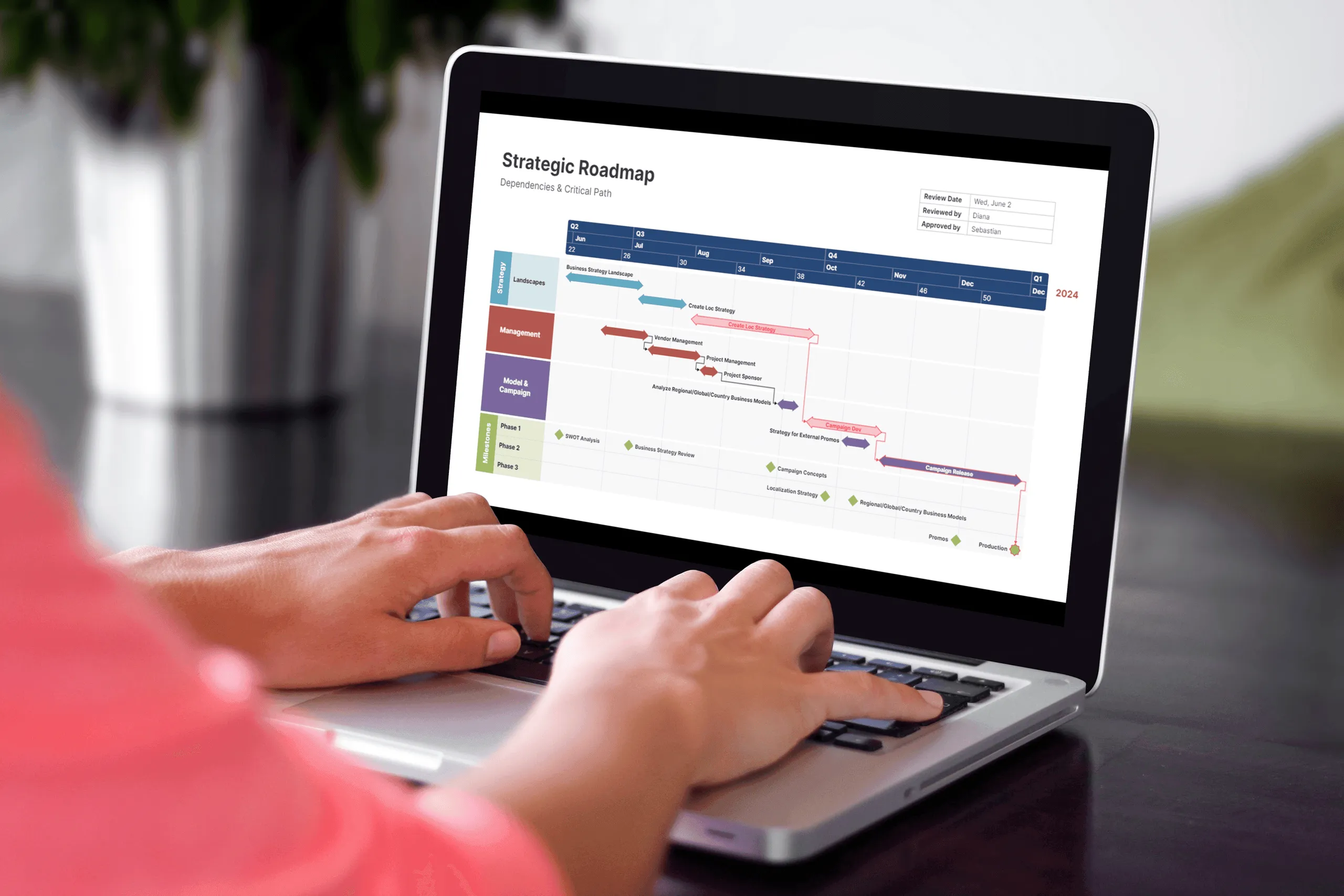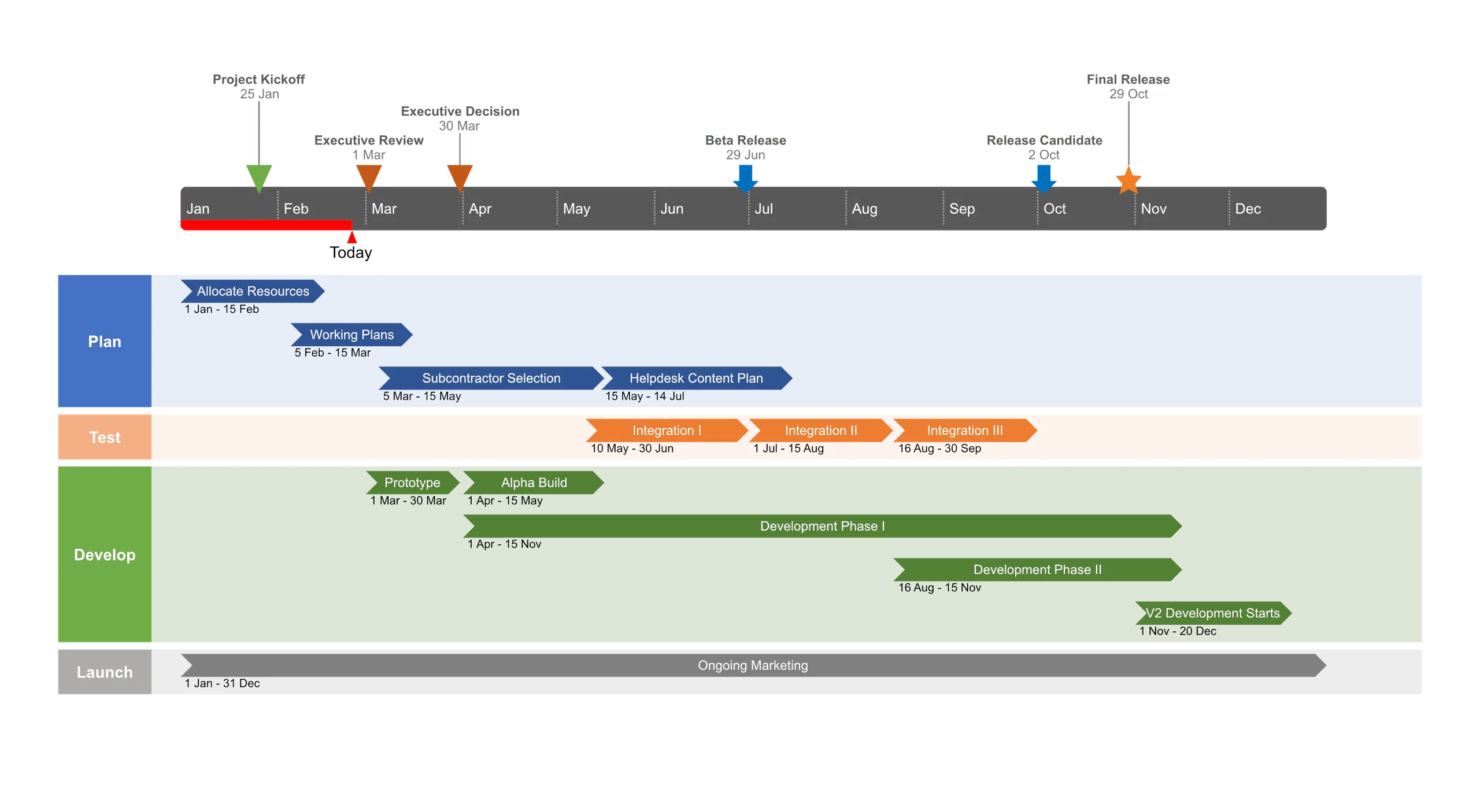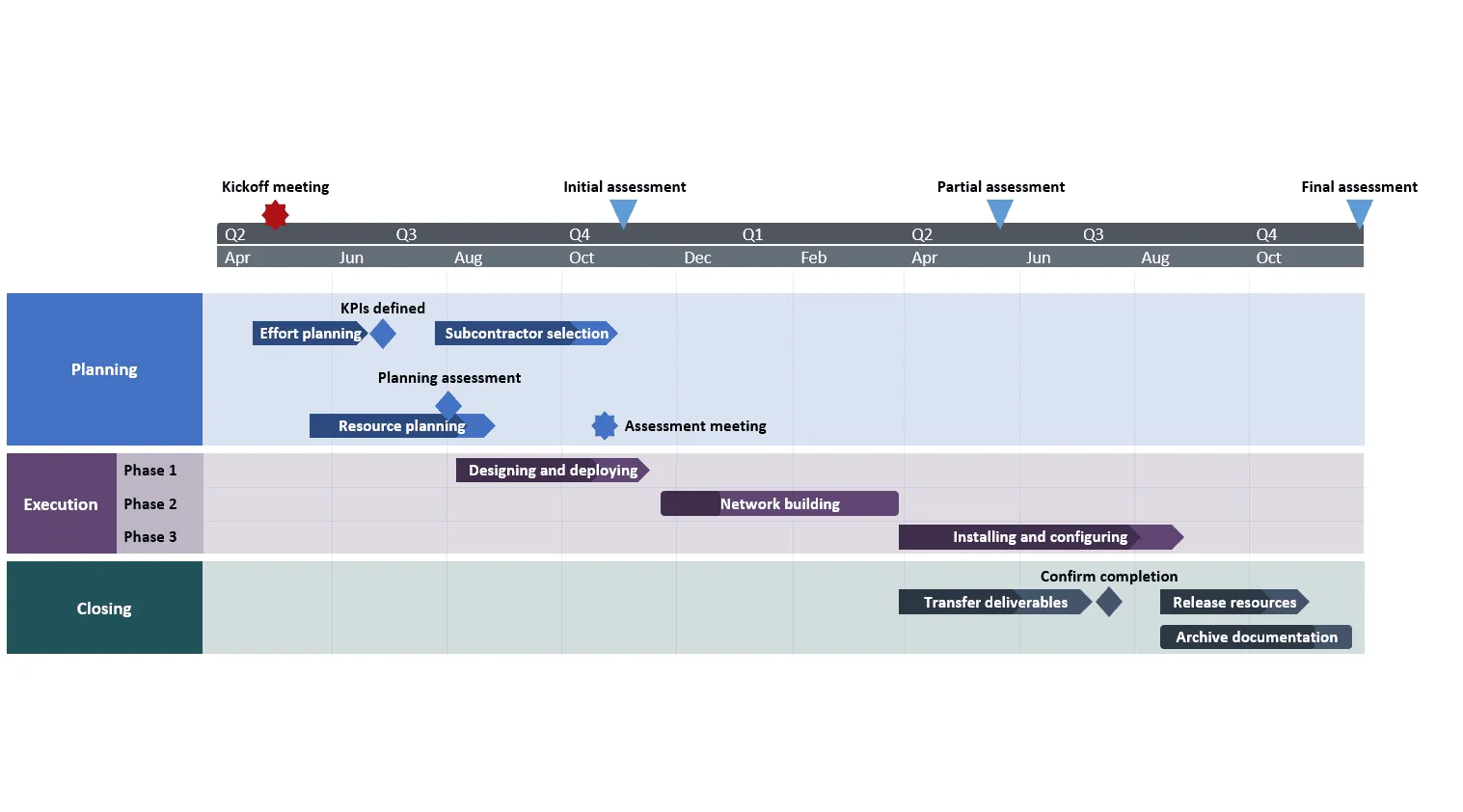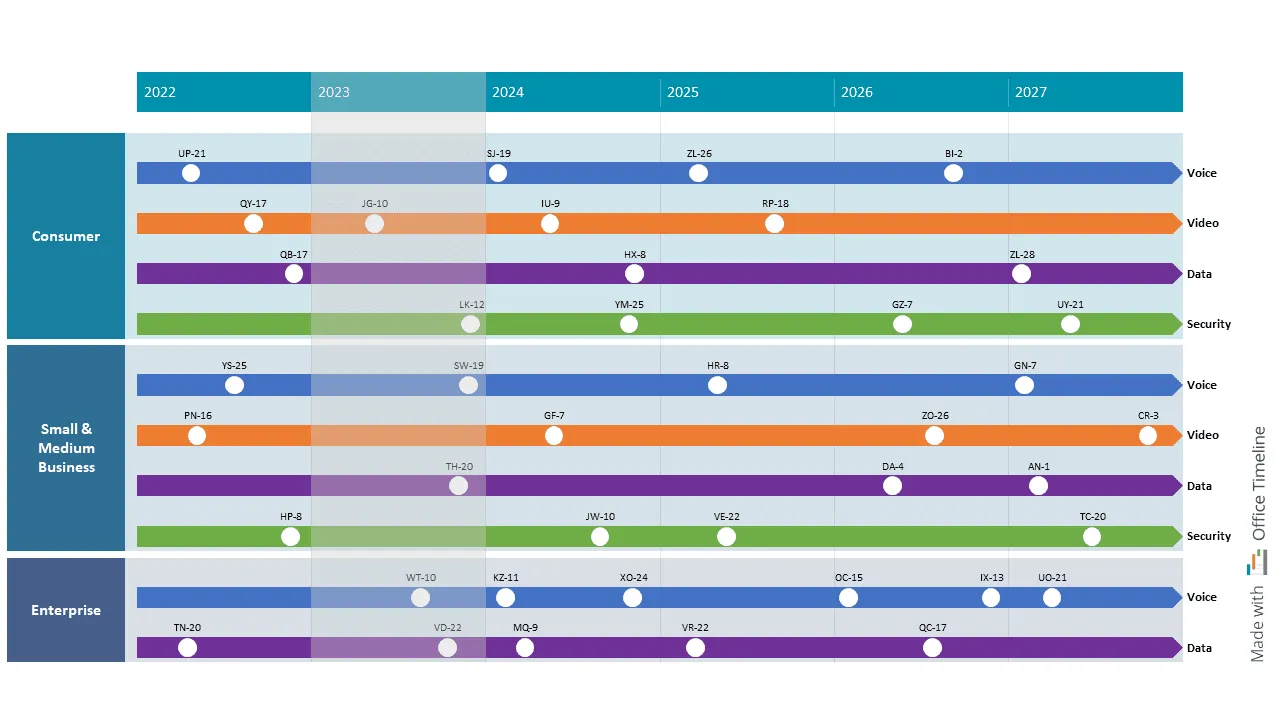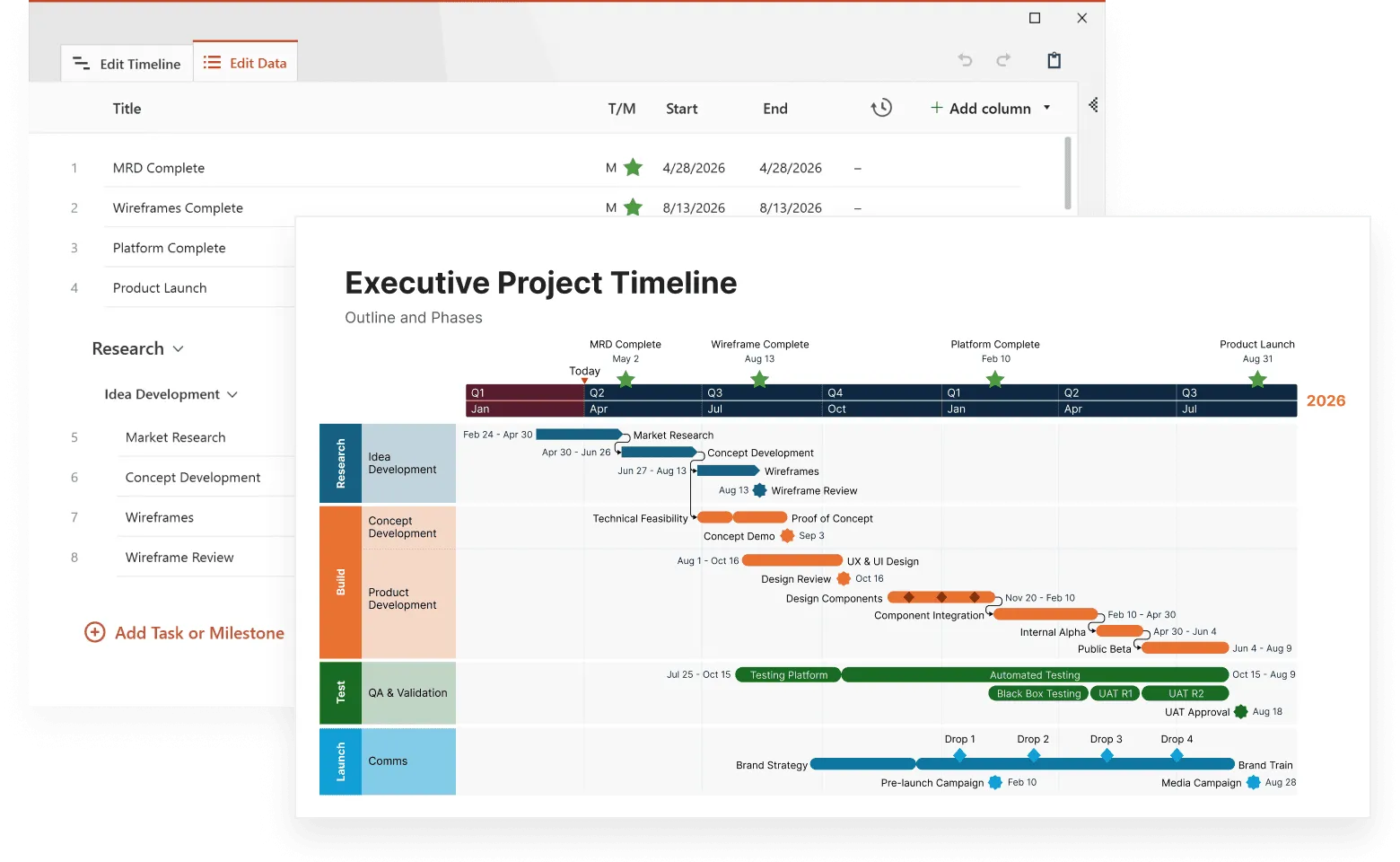Roadmap timelines offer a powerful visual way to show how your business grows or how projects progress over time. These visual tools help you organize tasks and milestones within distinct phases, making information easier to understand and virtually eliminating clutter.
A well-designed roadmap helps everyone understand what's happening when, who's responsible for what, and how all the pieces fit together to achieve your business goals.
In this article, you'll discover how to create and implement effective roadmap timelines with swimlanes, including different types for various business needs, design best practices, real-world examples, and practical tools.
We'll explore the unique benefits of swimlane roadmaps, strategic considerations, and answer common questions to help you build better visual plans for your team or organization.
This guide is part of our series on different types of timelines, where you can explore various formats and learn when to use each one effectively.
What is a roadmap timeline?
A roadmap timeline is a visual planning tool that outlines key initiatives, milestones, and goals over a defined period. It connects strategic objectives with scheduled actions, showing what needs to happen and when. Unlike a simple project plan, a roadmap timeline emphasizes direction and priorities, helping teams and stakeholders understand how short-term tasks align with long-term vision.
Roadmaps work perfectly for showing:
- how products develop over time,
- the phases of business growth,
- strategic plans and initiatives,
- project targets and completion dates,
- implementation schedules.
Roadmaps help everyone see what's happening, and why it matters. They connect day-to-day work with bigger business goals, showing how individual efforts contribute to the larger picture.
Types of roadmap timelines
Roadmaps come in different forms depending on what you need to plan and communicate. On this page you'll find six of the most common roadmap templates you can use in your next stakeholder meeting. Each type serves a specific purpose while maintaining the core benefit of visual clarity.
Product roadmap
A product roadmap is an easy way to lay out your plans for a product: what you’re building, when it’s coming, and how it all fits together. It shows both the big picture and the steps in between, so everyone knows where things are headed.
You’ll usually see things like:
- new features and versions,
- major updates,
- tech improvements,
- market rollouts.
Teams use these roadmaps to stay on track, especially when lots of things are happening at once, like development, testing, and launches. For example, a software team might use a roadmap to coordinate tasks across design, development, and release cycles, keeping everyone aligned on key milestones like beta release, integration stages, and final deployment.
Take a look at the example below. This roadmap was made in Office Timeline and shows how a product is planned, built, tested, and released across one year. It highlights important steps like beta and final release dates, testing milestones, and development phases, all lined up clearly so nothing gets missed.
Using a roadmap like this helps everyone stay in sync and focused on what matters, whether you’re managing one product or many.
Project roadmap
A project roadmap is a clear, high-level view of your project goals and how you plan to reach them. It shows major phases, key tasks, and milestones grouped in a way that makes progress easy to track.
When managing any kind of project, you'll probably need to create a project roadmap. When you build it, it's best if you present project tasks, milestones, and goals or initiatives grouped on various swimlanes.
A typical project roadmap includes:
- major milestones,
- handoff points between phases,
- resource planning periods,
- task dependencies.
Project managers use visual roadmaps like this to keep teams and stakeholders informed as the project evolves. Take a tech project, for instance: you might outline phases like planning, prototyping, integration, and rollout. A roadmap makes it easy to show how these pieces connect and what needs to happen when.
Strategic roadmaps
When you have a big plan, like growing your business, it helps to see the whole picture. That’s where a strategy roadmap comes in. It’s a clear visual that shows the key steps and when they happen. It’s especially useful when your plan covers different areas (like products, markets, or teams) and stretches over months or even years.
This kind of roadmap makes it easier to talk with others about your vision. Whether you're working with partners, investors, or your own team, showing them a big-picture plan helps keep everyone on the same page.
A good strategic roadmap often includes:
- your long-term goals,
- what the market looks like,
- where you want to improve or grow,
- and what you plan to invest in.
Leaders use roadmaps like this to stay focused and guide their teams through change. For example, a small restaurant might map out a three-year plan to refine their menu, start catering, open a second location, and eventually sell a packaged food line.
Take a look at this example below. It’s a strategy roadmap made with Office Timeline in PowerPoint:
This roadmap breaks things down into three stages: Planning, Execution, and Closing. Each part has clear tasks, meetings, and assessments shown along a timeline.
It’s easy to follow and gives a clear sense of how everything fits together, from early planning and resource setup to the final review and handoff.
Tools like Office Timeline make it simple to build roadmaps like this. You just enter your dates and tasks, and it turns them into a clean, professional visual you can share with your team or show in meetings.
Create clearer strategic roadmaps
Try Office Timeline for free. Turn your plans into polished, easy-to-present timeline visuals directly in PowerPoint.
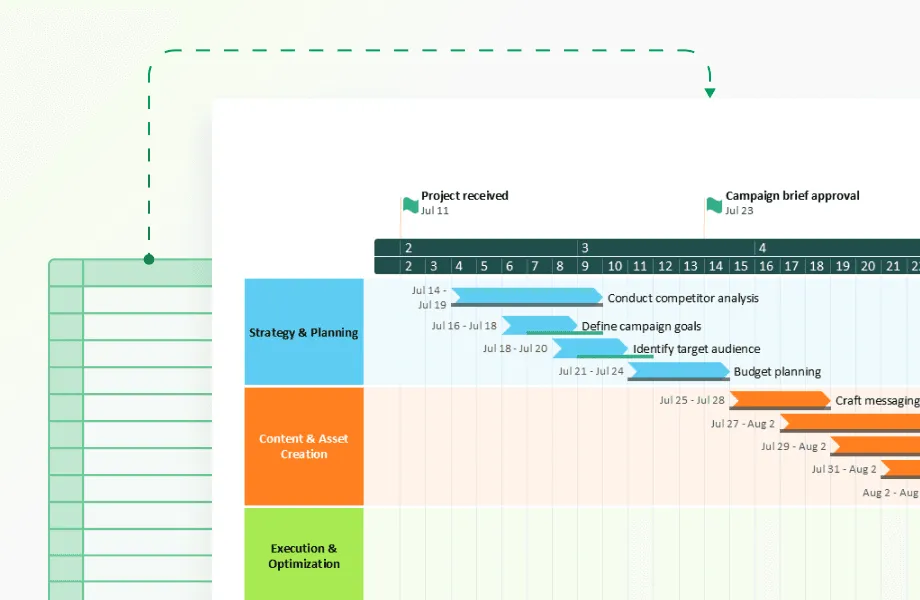
Creating effective roadmap timelines with swimlanes
When you build your roadmap, it's best if you present project tasks, milestones, and goals or initiatives grouped on swimlanes. The swimlane design requires thoughtful planning of several elements to make it truly useful:
Swimlanes organization
Swimlane diagrams bring an extra layer of order to your project roadmaps by grouping certain milestones, tasks or processes into "swimlanes" according to their category - it can be departments, employees, steps, or procedures.
You can organize swimlanes by:
- functional teams (marketing, development, sales),
- product categories,
- project phases,
- business objectives.
For example, a software development roadmap might have separate swimlanes for Backend Development, Frontend Development, User Testing, and Marketing, showing how these different workstreams progress in parallel.
Timeline scale
Choose time increments (weeks, months, quarters, years) that make sense for your roadmap's purpose and audience. A short-term project might need weekly markers, while a five-year business strategy works better with quarterly or yearly divisions.
The first row in your table will be built as a timeline band, being the horizontal axis of your roadmap. List the time units of your choice (months, quarters etc.) so that you can use them as time reference for the tasks and milestones you'll include in your roadmap.
Visual hierarchy
Use size, color, and position to show what's most important and how things relate to each other. Big initiatives or major milestones should stand out visually from smaller updates or minor features.
For each product category, select a different color while keeping it consistent across swimlanes. Also, pick a contrasting color to make the milestones stand out on the timelines.
Simplicity
Include only what people need to know to prevent overwhelming them. Too much detail makes roadmaps hard to understand and quickly outdated.
Instead of listing every small feature in a product roadmap, group related features into themes that represent meaningful improvements for users - like "Shopping Experience Improvements" rather than listing "Cart Update," "Wish List Function," and "Related Items Display" separately.
Flexibility
Design your roadmap to handle changes as projects evolve. Almost nothing goes exactly as planned, so roadmaps need to adapt to new information, shifting priorities, and timeline adjustments.
Using time ranges rather than specific dates (Q1 2023 instead of January 15, 2023) gives you necessary flexibility while still setting clear expectations.
Consistency
Keep visual elements consistent throughout your timeline. Use the same shapes, colors, and formatting for similar types of information across the entire roadmap.
If blue circles represent customer-facing features in one section of your roadmap, they should mean the same thing everywhere else too. This visual consistency helps people understand your roadmap without constantly checking a legend.
Real-world roadmap examples with swimlanes
Several fields benefit from swimlane roadmap designs that make complex information easier to follow:
Technology roadmap with swimlanes example
Coming up with a strategy for managing technological updates in your organization has never been easier, thanks to swimlane template roadmaps you can use for your next PowerPoint presentation.
All tasks and milestones can be consolidated within distinct phases of the project, significantly improving the readability of your Gantt charts or timelines and virtually eliminating clutter. Check out the roadmap templates library from Office Timeline.
For example, a technology roadmap might include swimlanes for infrastructure upgrades, software implementations, security enhancements or user training initiatives.
Each swimlane shows exactly what’s going on in that area over time, so it’s easy to follow how different tech initiatives are moving forward side by side.
Marketing roadmap with swimlanes example
Including swimlanes in roadmaps for PowerPoint presentations has the advantage of consolidating the tasks and milestones of your campaigns, according to the phase of the campaign where they belong.
A marketing roadmap might include swimlanes for content marketing, social media campaigns, email marketing, event marketing. This organization makes it easy to see how different marketing efforts are coordinated and timed to support business goals.
Telecom project roadmap example
The telecom industry sits at the heart of our modern world, keeping millions of people and businesses connected in real time regardless of geographic location.
With each new technology integrated into the telecom infrastructure, be that 5G, artificial intelligence or IoT, companies need to shift their strategy and transition to improved products and services as smoothly and fast as possible.
A telecom roadmap might include swimlanes for network infrastructure, service offerings, customer experience, regulatory compliance. Such a comprehensive view helps coordinate the complex interdependencies between different aspects of telecommunications projects.
Benefits of swimlane roadmap timelines
The swimlane design of these roadmaps offers several practical advantages that make them worth considering for your next planning exercise:
Improved organization
Swimlane diagrams bring an extra layer of order to your project roadmaps by grouping certain milestones, tasks or processes into "swimlanes" according to their category. This organization makes complex information much easier to understand.
Clear responsibility assignments
Swimlanes make it obvious which team or department is responsible for which deliverables. This clarity helps prevent confusion about ownership and accountability.
Better visualization of parallel work
By organizing related activities into swimlanes, it becomes easier to see how different workstreams progress simultaneously and how they depend on each other.
Enhanced communication
The project roadmap is an extremely useful tool for stakeholder buy-in and communication, since it helps create a common understanding on the strategic reasons for sponsoring a project. When all stakeholders are on the same page, you can overcome obstacles easier and deliver your project on time and within budget.
Tools for roadmapping
Several tools can help you create winding roadmap timelines without starting from scratch:
Specialized roadmapping software
Dedicated roadmapping tools offer templates specifically designed for curved roadmaps. These tools often include features tailored to specific roadmap types, like product or project roadmaps.
Tools like Roadmunk, ProductPlan, and Aha! provide specialized features for creating and sharing professional roadmaps, though they typically require a subscription.
Presentation software
Programs like PowerPoint or Google Slides allow custom shape creation, which you can use to design winding roadmaps. While less specialized than dedicated roadmapping tools, they offer flexibility and are often already available to teams.
With a bit of creativity, you can create impressive roadmaps using shapes, text boxes, and connectors in these familiar programs.
Visual collaboration platforms
Tools like Miro or Mural provide flexible diagramming features that work well for collaborative roadmap creation. These platforms allow multiple team members to contribute to roadmap development simultaneously.
These tools shine when you need input from different departments or stakeholders who might not be in the same location.
Project management tools
Many project management platforms include roadmap visualization options that can be adapted to create winding designs. These have the advantage of connecting directly to project data and tasks.
Tools like Asana, monday.com, and Jira offer roadmap views that can update automatically when underlying project data changes, saving you from manual updates.
Professional roadmapping tools
Specialized roadmapping software goes beyond basic visualization to offer purpose-built features that streamline the creation of polished, professional roadmaps. These tools typically include extensive template libraries, automatic formatting options, and integration capabilities with other business applications.
A notable example is the Office Timeline add-in for PowerPoint, which combines ease of use with professional-grade capabilities. This tool is particularly valuable because it:
- creates roadmaps directly in the familiar PowerPoint environment,
- imports data from Excel, MS Project, Wrike and other tools,
- automatically formats and updates your roadmaps,
- uses swimlanes to organize information clearly.
The transition from basic presentation software to dedicated tools like Office Timeline can dramatically reduce the time spent creating and maintaining roadmap visualizations while enhancing their visual impact and clarity.
Implementing roadmap timelines effectively
For maximum impact, consider these practical implementation tips:
Regular updates
Schedule periodic reviews to keep the roadmap current with changing conditions. Outdated roadmaps quickly lose credibility and usefulness.
A good practice is to review product roadmaps at least quarterly, with a quick monthly check to catch any major changes that need immediate attention.
Accessibility considerations
Make sure the visual design works for all stakeholders, including those with visual impairments. Use colorblind-friendly palettes and include text descriptions of key elements.
Avoid relying solely on color to convey meaning. Use shapes, patterns, or labels to distinguish between different types of roadmap elements, ensuring everyone can understand the information regardless of how they perceive color.
Context provision
Include enough background information to make the roadmap meaningful to viewers. Even the prettiest visual won't help if people don't understand what they're looking at.
Consider adding a brief introduction that explains the roadmap's purpose, timeframe, and how to interpret its elements. This context helps new team members or external stakeholders quickly get up to speed.
Feedback mechanisms
Create ways for stakeholders to comment on or question roadmap elements. Roadmaps should encourage conversation.
Digital roadmaps might include comment features, while printed versions could be presented in meetings that allow for discussion and questions. This feedback helps refine both the roadmap itself and the plans it represents.
What to consider when planning your strategic roadmap
When creating a strategic roadmap, several factors significantly impact how effective it will be:
Clear vision communication
Make sure your roadmap clearly shows where you're headed and how you'll measure progress. Everyone viewing the roadmap should understand the destination and why it matters.
For example, a healthcare technology company's roadmap might show their progression from offering single-purpose apps to building a connected platform that integrates various aspects of patient care, with clear indicators of what success looks like at each stage.
Stakeholder identification
Different audiences need different views of your roadmap. Internal teams need more detail, while executives and customers often prefer higher-level perspectives.
Consider creating variations of your roadmap for different stakeholders:
- Executive view: Focus on business outcomes and major milestones.
- Team view: Include more implementation details and responsibilities.
- Customer view: Emphasize benefits and improvements they'll experience.
Competitive awareness
Your roadmap should reflect an understanding of market conditions and competitive positioning. This doesn't mean sharing confidential information, but your plan should acknowledge market realities.
A roadmap showing plans to introduce features that competitors already offer should acknowledge this context, perhaps by emphasizing your unique approach or the additional value you'll provide.
Single source of truth
The roadmap should serve as the one reference point that all stakeholders can rely on for consistent information. When multiple versions exist, confusion follows.
Maintain a master version of your roadmap in an accessible location, with clear version history to track changes over time. This prevents the confusion that comes from different teams working from different versions of the plan.
Conclusion
Roadmap timelines with swimlanes offer an effective way to show complex business cycles and project progressions. Swimlane diagrams bring an extra layer of order to your project roadmaps by grouping certain milestones, tasks or processes into "swimlanes" according to their category, making complex information easier to understand and navigate.
Whether you're planning product development, mapping organizational strategy, or communicating project phases, a well-designed roadmap timeline helps connect your vision to concrete actions and timelines.
By choosing the right format, tools, and implementation approach for your specific needs, you can create roadmaps that effectively guide your team and stakeholders through the path ahead.
For your next planning exercise, consider how a swimlane roadmap design might improve clarity and engagement. The visual organization and clear structure make these roadmaps particularly effective for complex initiatives with multiple parallel workstreams or significant interdependencies.
Frequently asked questions about roadmap timelines
Below are answers to some common questions people have when creating and using roadmap timelines in their organizations. These practical insights can help you avoid common pitfalls and make the most of your roadmapping efforts.
Your roadmap should include enough detail to guide action without becoming a project plan. Focus on outcomes rather than tasks - what you'll achieve rather than how you'll achieve it. A good rule of thumb: if you can't explain each element in a single sentence, it's probably too detailed for a roadmap.
For most businesses, quarterly updates work well as a baseline, with more frequent adjustments for fast-moving projects or volatile markets. The key is finding a balance - update too often and you create confusion, too rarely and your roadmap becomes irrelevant. Set a regular review schedule but be ready to make unexpected changes when significant shifts occur in your business environment.
The most common mistake is treating the roadmap as fixed rather than flexible. Roadmaps are planning tools, not contracts. When market conditions change or new information emerges, the roadmap should adapt. Teams that stick rigidly to outdated roadmaps often deliver products or projects that no longer meet current needs.
Create different versions for different audiences. Your internal roadmap might include specific competitive strategies, while your customer-facing version focuses on planned features and benefits. For investor roadmaps, emphasize growth potential and market opportunities. Always clearly mark confidential versions and control their distribution carefully.

